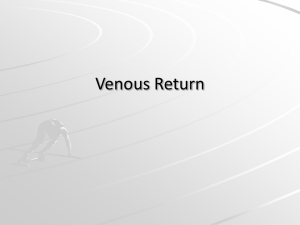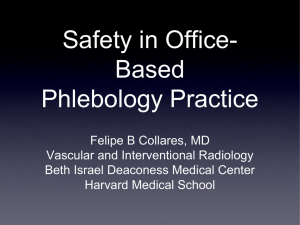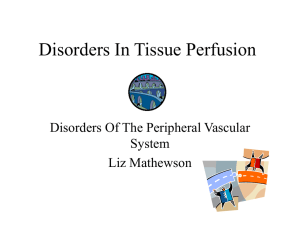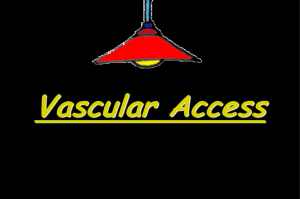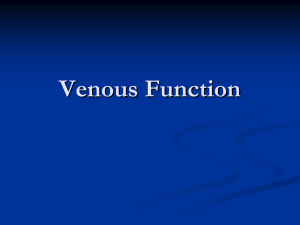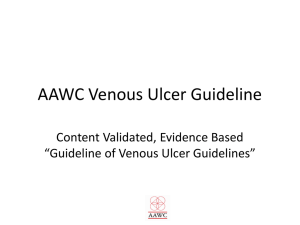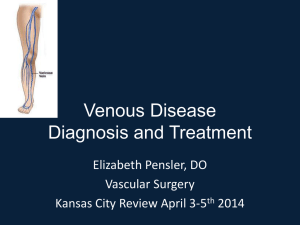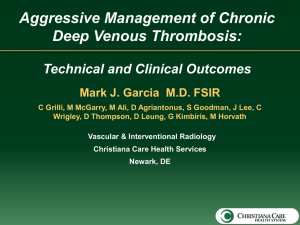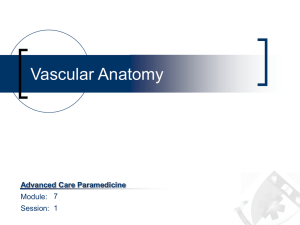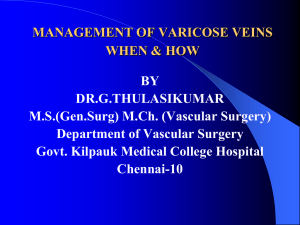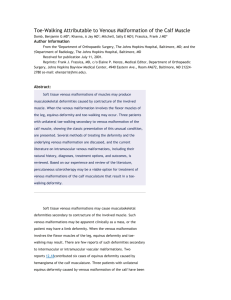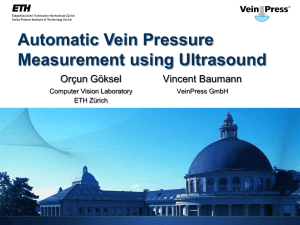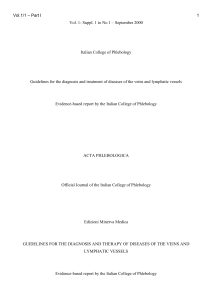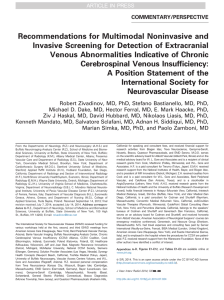Venous stasis ulcers
advertisement
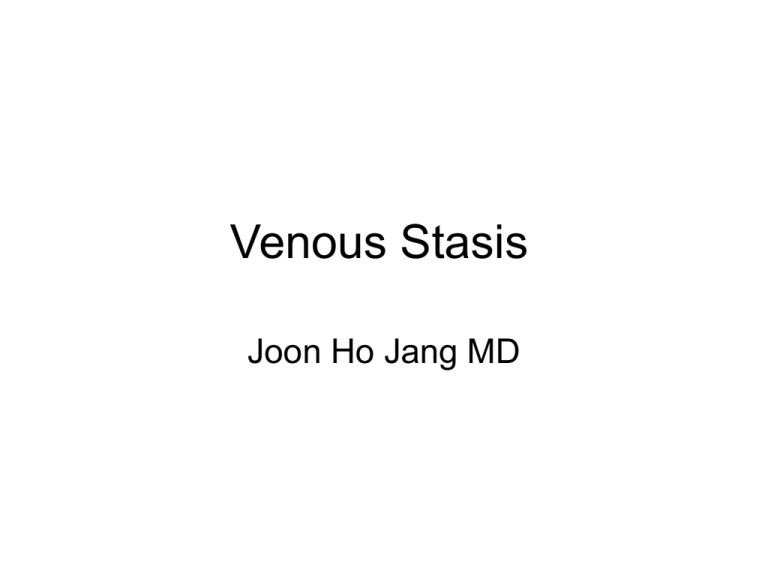
Venous Stasis Joon Ho Jang MD Incidence/Prevelance & JOBST Coverage • It is estimated that more than 80 million Americans suffer from some form of venous disorder. • Up to 13 million people in the U.S. suffer from CVI • Peak incidence occurs in women aged 40-9 and men aged 70-79 years • Statistics show one in three Americans over the age of 45 is affected by vein disease, and of those, only 4% are being treated. • Annual health care cost in the US to treat CVI is about $3billion; about 2 million workdays are lost per year due to venous ulcers Varicose Veins • More than 24 million Americans have varicose veins • Up to 50% of women have varicose veins while 24% of men aged 30-40 and 43% of men over 70 have varicose veins DVT / PTS • There are over 200,000 new cases of DVT each year in the U.S. • The incidence of pulmonary embolism in patients with DVT ranges from 5 – 20% and can be fatal • After an episode of DVT, 20 – 50% of patients develop Post Thrombotic Syndrome within the first 2 years Venous Stasis Ulcers • Affect 2.5 million people in the U.S. • An estimated 500,000 persons are newly diagnosed each year Venous Stasis…How? • Mechanics • Structure • Inflammation • Pressure • Obstruction- DVT Function • Transport blood back to the heart • Prevent intravascular volume overload Anatomy • Tunica intima: endothelium with BM and elastic lamina – Produces endothelium derived relaxing factor and prostacyclin • Tunica media: Circumferential SM – Maintains venous pressure gradient • Tunica externa: Collagen – Stability Valves • Venous valves: – One way – Two cusps of CT skeleton covered by endothelium – Closure at > 30cm/s – Exception: IVC, common iliacs, portal, cranial sinus Lower Extremity Venous Hypertension – Hydrostatic pressure vs Mechanical/muscular pressure • • • • A. K. Tassiopoulos et al. 1153 cases of ulcerated legs and venous disease Reflux in superficial, deep, and perforating veins Incompetent valves Valvular Dysfunction • Physical damage: splitting, tearing, thinning, adhesion to wall • Reduction in number – Not age related • Monocyte and macrophage infiltration – Overexpression of Intracellular adhesion molecules – Wall hypertrophy, disruption of collagen synthesis, and destruction of extracellular matrix proteins Shear Stress and Inflammation • Pulsatile venous blood flow • Valve closes: Pvortical > Pluminal – Minimal shear stress • Low shear stress starts cascade of inflammatory signals Risk Factors • Genetic • More in females • Hormones – Progesterone, estrogen • • • • • Pregnancy Age: >50 Greater height Prolonged standing Obesity Signs and Symptoms • • • • • • Telangiectasias Reticular veins Varicosity Thrombophlebitis Hyperpigmentation Bleeding from clusters • Ulceration • • • • • • • Aching Heaviness Early fatigue Edema Itching Restless legs Cramps Physical Exam, Diagnostic Tests • Palpable veins • Perthes Test – For deep venous patency – Tourniquet and walk • Brodie-Trendelenburg Test – For superficial vein and valve patency – Venous filling time: normal- within 35 secs • Duplex Ultrasound • Venography Classification: CEAP *Eklof et al. J of Vasc Surg 2004 Clinical classification • C0: no visible or palpable signs of venous disease • C1: telangiectasies or reticular veins • C2: varicose veins • C3: edema • C4a: pigmentation or eczema • C4b: lipodermatosclerosis or atrophie blanche • C5: healed venous ulcer • C6: active venous ulcer • S: symptomatic, including ache, pain, tightness, skin • irritation, heaviness, and muscle cramps, and other • complaints attributable to venous dysfunction • A: asymptomatic CEAP Etiologic classification • Ec: congenital • Ep: primary • Es: secondary (post-thrombotic) • En: no venous cause identified Anatomic classification • As: superficial veins • Ap: perforator veins • Ad: deep veins • An: no venous location identified Pathophysiologic classification • • • • • Basic CEAP Pr: reflux Po: obstruction Pr,o: reflux and obstruction Pn: no venous pathophysiology identifiable Treatment • Compression Therapy – Stockings, Unna’s Boot • Drug Therapy • Surgery Compression Stockings • Worn during the day • Elastic stockings with adjustments in pressure • Lower pressure stockings (20-30mm Hg) for edema and DVT prophylaxis • Higher pressure (3040+mm Hg) for ulcers and significant venous disease • Operator dependent – Difficult to put on – Physical impediments/Comorbidities • 50% of patients were unable to them on alone • 30-65% noncompliance noted in clinical trials in venous centers Efficacy of Compression Therapy 1. 22 trials comparing healing of venous ulcers using compression stockings • • • Compressive therapy more effective than non-compression Higher pressure were more effective than lower Multilayer compression was better than single layer bandaging 2. 466 patients with a healed ulcer • Continued use of compression stocking reduced reoccurrence within 3-5 year 3. ESCHAR study: 500 limb trial that compares surgery and compression vs. compression alone for ulcer treatment • Combination therapy had lower rates of reoccurrence of ulcer at year 4 (24% vs. 52%) Drug Therapy • Pentoxifylline – PDE4 inhibitor that increases intracellular cAMP and stimulates protein kinase A activity – Reduces blood viscosity and decreases platelet aggregation and thrombus formation – Variable efficacy More invasive • Sclerotherapy – 0.2% sodium tetradecyl injected directly into spider angiomas and smaller superficial varicosities • Complications (<5%): allergic reaction, hypo/hyper-pigmentation, local skin necrosis • Endovenous laser ablation of saphenous vein (EVLT) • Surgical excision of veins (“Stripping”) Efficacy • Meta-analysis of 64 studies (12,320 legs) – – – – Anaylzed ablation via Duplex US Follow upto 5 years Success rate of EVLT highest after 5 years Complications: DVT (<3%), local bruising and pain, paresthesias, foam emboli, stroke Works Cited • • • • • • • • • • • Raju et al. Chronic venous insufficiency and varicose veins. NEJM 2009;360:231927 Bergan et al. Chronic venous disease. NEJM 2006;355:488-98. Tassiopoulos et al. Current concepts in chronic venous ulceration. Euro J Vasc Endovasc Surg 2000;20:227-232. Ono et al. Monocyte inflitration of venous valves. J Vasc Surg 1998;27:158-66. Sansilvestri-Morel et al. Imbalance in the synthesis of collagen type I and collagen type III in smooth muscle cells derived from human varicose veins. J Vasc Res 2001;28:560-8. Jacob et al. Extracellular matrix remodeling in the vascular wall. Pathol Biol 2001;49:326-32 Eklof et al. Revision of the CEAP classification for chronic venous disorders: Consensus statement. J Vasc Surg 2004;40:1248-52. Cullum et al. Copression bandages and stockings for venous leg ulcers. Cochrane Database Syst Rev 2000;2: CD000265 Mayberry et al. Fifteen-year results of ambulatory compression therapy for chronic venous ulcers. Surgery 1991;109:575-81. Barwell et al. Comparison of surgery and compression with compression alone in chronic venous ulceration (ESCHAR study): randomised controlled trial. Lancet 2004;363:1854-9. Van den Bos et al. Endovenous therapy of lower extremity varicosities: a metaanalysis/ J Vasc Surg 2009;49:230-9.

